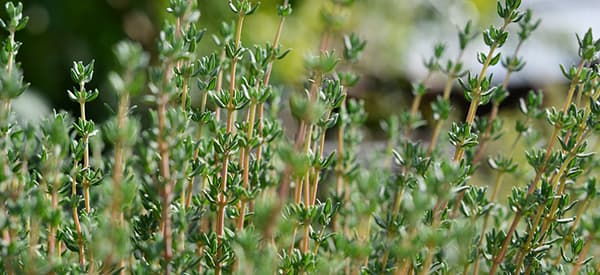
Thyme
Thyme (Thymus vulgaris) is a dainty evergreen herb. It is a staple for many culinary uses. It lends a slightly earthy, minty, and lemony flavor profile to dishes. Thyme is commonly added to meat, vegetables, soups, sauces, cocktails, and many Mediterranean cuisines. Interestingly, thyme is rooted in tradition and culture contained in many ancient folklores. Thyme is also worn by the bravest knights as a symbol of their courage during Medieval times.
Thyme exists in many ancient beliefs since it plays a prominent role in folklore. People believed it gives protection against nightmares, evil spirits, and plagues. The scent of burning thyme is used as a freshener in temples. It is also an important herb in mummification and funeral rituals. The plant is said to guarantee successful passage into the afterlife. Presently, thyme plays a role in medicine, soap-making, and perfumery.
Thyme’s origin can be traced back to the Mediterranean about 5,000 years ago. In the 11th century, monks brought the herb into Northern Europe. The plant cannot tolerate the freezing temperature, but the Northerners breed varieties that can survive the frost. The ancient Egyptians were said to be the first to use thyme for embalming rituals, while the Greeks used it in their baths and temples. It was used to treat skin lesions during the Black Death because of its antiseptic property.
Where Thyme Is Found
Thyme is an herb that is popularly cultivated worldwide. It prefers growing in warm and sunny places similar to the dry and rocky soils of the Mediterranean. In this conducive environment, thyme is a low-maintenance plant. There are many cultivars of this species adapted to various climates where they are mostly grown as a culinary herb.
⇒ The Complete Map of Edible Plants: Find Out What You Have in Your Area! (Video)
How To Identify Thyme
Common thyme is an aromatic and bushy semi-woody herb. It is particularly identifiable for its linear leaves and flowering tops. Its tiny tubular flowers attract bees, making thyme a great addition to pollinator gardens.
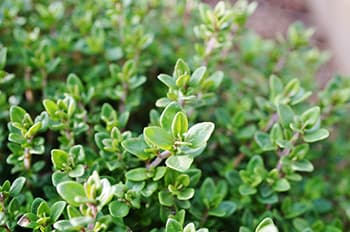 Leaves. Thyme leaves are tiny with a dark and grayish-green color. They are linear to ovate with pointed tips, simple, and arranged opposite each other on the stem. The length and width of a thyme leaf are no more than an inch in size, and its leaf margins roll underneath. In its flowering stage, the leaves are very aromatic, and they are edible whether they are fresh or dried.
Leaves. Thyme leaves are tiny with a dark and grayish-green color. They are linear to ovate with pointed tips, simple, and arranged opposite each other on the stem. The length and width of a thyme leaf are no more than an inch in size, and its leaf margins roll underneath. In its flowering stage, the leaves are very aromatic, and they are edible whether they are fresh or dried.
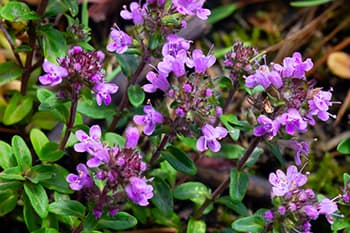
Flowers. The flowers of a thyme plant appear in a dense cluster or whorls on the tip of the stem. These spikes of small flowers are white or pinkish to lavender.
It has a tubular shape with two lips and four protruding stamens.
The showy flowers bloom in spring or summer.
Fruits and Seeds. Thyme produces tiny fruit with minute seeds. The fruit is only about an inch in length and width with a brown to copper color. It grows schizocarp or dry fruits that split into a single-seeded section called mericarps. Each section holds one or more tiny thyme seeds.
Roots. Thyme grows from woody, fibrous roots with numerous branched stems. The roots are round and hard with a reddish-brown color growing to about 4 to 8 inches.
Stem. Thyme is a bushy, evergreen herb with a woody base growing from 6 to 12 inches (15 to 30 cm). The upper stems are semi-woody, angular, and upright, with fine hairs distributed evenly in the stem.
⇒ Plant Identification Guide – 400 Wild Plants That You Can Forage For (Video)
Thymus vulgaris is a culinary herb known by names such as the common thyme, German thyme, garden thyme, German winter, or thyme. Thyme belongs to the Lamiaceae family.
Common thyme is a dwarf plant with important cultivars or varieties such as:
- Argenteus, thyme with green and creamy white leaves
- Broadleaf English, thyme with broad and small leaves, often with a sweeter aroma
- Dot’s Well, thyme with small and narrow leaves
- Gray Hill, has pale lavender flowers
- Orange Balsam or orange-scented thyme
How To Grow Thyme
Thyme is cultivated mainly as spice and ornamental in many gardens. Luckily, the plant has adapted to changing seasons and can grow everywhere. This rustic evergreen herb is low maintenance although it can get leggy if left untrimmed. Thyme is hardy in USDA zones 5 to 9, and they particularly flourish when they have access to full sun and evergreen in mild winters.
The common method of propagating thyme is through seeds or stem cuttings. They are fairly difficult to grow from seeds since they take too long to germinate and grow. But, if you do not have the parent plant to start from, it is still possible to buy thyme seeds from online stores.
The most viable way of growing thyme that most people prefer is through its root or stem cutting.
Growing Thyme from Seeds
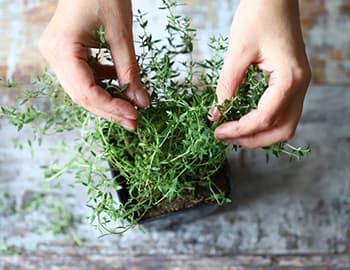 Thyme has uneven germination, and the ideal way of starting the seeds is from cold stratification or overnight soak. You can start them indoors in peat pots 6 to 20 weeks before the last frost.
Thyme has uneven germination, and the ideal way of starting the seeds is from cold stratification or overnight soak. You can start them indoors in peat pots 6 to 20 weeks before the last frost.
Scatter the seeds into the soil surface and do not cover it with soil so it can get the sunlight it needs. Place the pot in a place with an ideal temperature of 70⁰F and keep the soil moist. Thyme may germinate after 10 to 21 days.
Harden the seedlings for a week or two before transplanting them into individual pots or gardens.
Growing Thyme from Cuttings
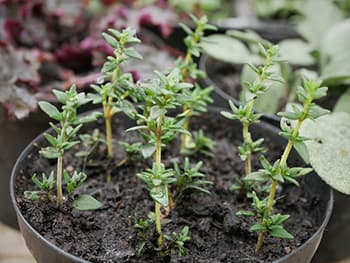 To grow thyme from cutting, snip off a not too woody stem tip about 3 inches long. Remove the bottom leaves, leaving two or three sets on the stem. A rooting hormone may help speed up the growth, but it is not necessary.
To grow thyme from cutting, snip off a not too woody stem tip about 3 inches long. Remove the bottom leaves, leaving two or three sets on the stem. A rooting hormone may help speed up the growth, but it is not necessary.
Plant the cutting in any potting soil mixed with sand and place it in an area with indirect sunlight. Do not cover it and keep the soil moist until new roots develop. When the roots are long enough to support the plant growth, transfer the new plant into the garden or larger container.
⇒ Stopped Spending Money At The Pharmacy By Growing These 10 Plants (Video)
Plant Care and Maintenance
The best thing about growing thyme is that it does not have many pests and disease problems. In fact, the plant can even repel insects, and they are deer resistant. The problem with thyme, however, is root rot when planted in too-rich soil with ample moisture.
Thyme care is as simple as providing it with the following conditions:
- Full sun, warm and humid environment
- Chalk, loam, and sandy well-draining soil
- Alkaline to neutral soil
- Good air circulation
- Diluted or half-strength all-purpose fertilizer
How To Harvest Thyme
Best time to harvest thyme for cooking is at dawn. Thyme’s oils are strongest at this time of day, so when you cook with it, the flavor will be more intense.
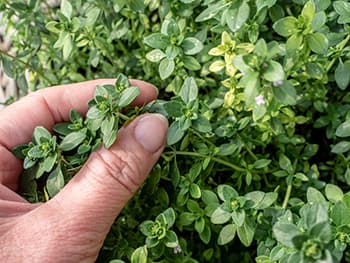
Harvest thyme by snipping off a few stems, leaving at least one-third of the plant.
You can store fresh thyme in tightly wrapped plastic in the refrigerator for a couple of weeks. Or, you can dry the herb thoroughly and store it for up to two years. Dry thyme by hanging the sprigs in a dry, warm, and well-ventilated area. When thoroughly dried, you can transfer them to an airtight container for storing.
What Thyme Is Good For And Natural Remedies Made From It
Historically, the Romans consume thyme before and during meals to protect them from poisoning. Present studies explored the action of thyme and discovered the antimicrobial activity in its essential oil. The essential oil from plants like thyme can extend the shelf life of meat to prevent foodborne illnesses.
Thyme is a mild antispasmodic helpful in preventing spasms during an asthma attack. It can also relieve common respiratory illnesses like cough, cold, bronchitis, and throat irritation. Thyme oil works against different bacteria strains in the oral cavity, respiratory tract, and genitourinary tract. It can also prevent infections.
Thyme may also control fungal infections because of its antifungal property. It acts against yeast infection caused by Candida albicans, which is often resistant to prescription medication. It is applied topically to minor cuts and wounds and used as a wash for toenail fungus and athlete’s foot.
Adding thyme to a daily meal can potentially lower the risk of hypertension and cardiovascular diseases. Its blend of antioxidants, minerals, and vitamins reduces stress in the cardiovascular system. It relaxes the blood vessels, thereby lowering blood pressure. Similarly, it boosts HDL (good cholesterol) and reduces LDL (bad cholesterol) and triglycerides.
⇒ 40 Interesting Home Reliefs from Our Grandparents That Could Help You (Video)
Thyme contains carvacrol, a compound that can boost the mood to ward off anxiety and stress. The carvacrol found in thyme can also inhibit tumor growth.
Using thyme and its essential oil may potentially cure the following health issues:
- Respiratory problems
- Cholesterol
- Cardiovascular diseases
 Blood pressure
Blood pressure- Anxiety, stress, and depression
- Bronchitis
- Oral and dental problems
- Bacterial and fungal infections
- Food poisoning
- Diarrhea, gastritis, and other gastrointestinal issues
- Bone disorders
- Parasitic worms
- Baldness
- Anemia
- Snakebite
- Recurring nightmares
- Wounds
- Boosts the immunity
- Supports brain health
- Tones up the nervous system
What Parts Of Thyme Are Used For Remedies?
Thyme is an edible herb, and its leaves are used as a fresh or dried seasoning in many dishes. In herbal medicine, thyme leaves, flowering tops, stems, and fruits are used for treating various illnesses.
Ground thyme is available, but it is mostly used for culinary purposes rather than medicine. For many centuries, brewed infusion of thyme leaves has been the most popular way of using the herb.
Thyme is also processed into herbal supplements. You may find it in liquid extract, essential oil, or capsule. Thyme oil is used as an all-purpose disinfectant and sometimes as a bug repellent.
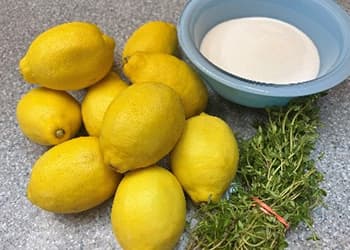
Refreshing Thyme Lemonade
Ingredients:
- 1 bunch of fresh thyme and more sprigs for garnish
- 1 ½ cup sugar
- 1 cup of water, 6 cups more water
- 2 cups fresh lemon juice
Steps:
1. In a saucepan over low heat, bring fresh thyme, sugar, and water to a boil. Stir until the sugar dissolves.
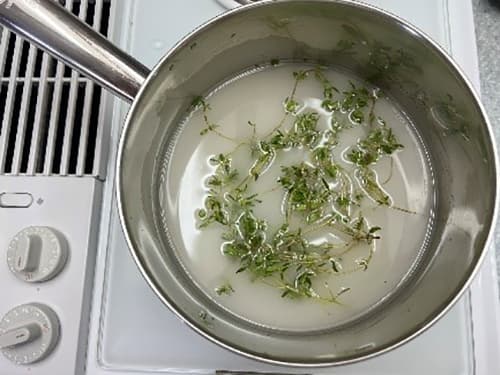
2. Remove from heat. Stir in the lemon juice, and add six more cups of cold water. Mix well.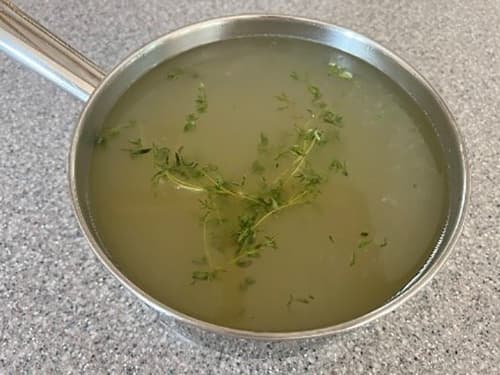
3. Strain the lemonade into a pitcher and refrigerate it until cold. Serve over ice with fresh thyme sprig garnish.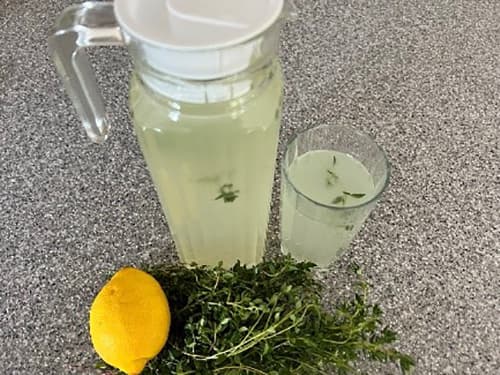
How to use this remedy
This refreshing and delicious mix is a good mood booster against the late summer heat. The lemonade can stay in the refrigerator for up to a week. You can also use this for any cocktail mix.
What Plants Resemble Thyme
| Features | Thyme (Thymus vulgaris) | Sweet Basil (Ocimum basilicum) | Rosemary (Salvia rosmarinus) |
|---|---|---|---|
 | 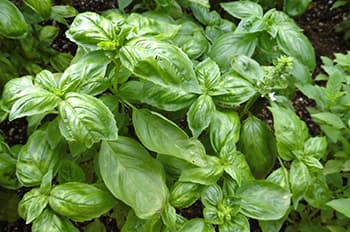 | 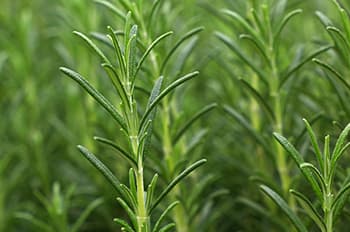 |
|
| Size | 0.5 to 1 ft | Up to 3 ft | 2 to 6 ft |
| Leaves | Dark grayish-green; linear to ovate; pointed tips; simple; opposite; tiny; aromatic | Green; glossy; simple; opposite; elliptic to ovate; fragrant | Grayish green/green; leathery; linear; simple; pointed tips; opposite; aromatic |
| Flowers | White/lilac; dense cluster; spikes; tubular-shaped; tiny; showy | White/pink/lavender; small; lip-shaped; showy | Blue/white; cluster; lipped; tiny |
| Fruits/Seeds | Brown/copper; tiny; schizocarp; minute seeds | Dry fruit with tiny seeds | Brown/copper; tiny; nutlets; schizocarp |
| Stem | Bushy; evergreen; woody to semi-woody; erect; angular; hairy | Green; angular; smooth; thin; hollow; branching | Woody; erect; branching; angular; scaly |
| Scent | Herbaceous; hot; minty; floral finesse | Warm, sweet, freshly floral | Pinewood-scent |
Warnings And Cautions
Thyme is edible and safe when taken as food or spice. However, its safety in large amounts as medicine is not yet proven. Thus, thyme herbal supplements are not recommended for pregnant and breastfeeding women.
Women with hormone-sensitive conditions like breast, uterine or ovarian cancer, uterine fibroids, or endometriosis should avoid thyme supplements. Thyme can act like estrogen in the body and worsen the condition.
Thyme will also slow down blood clotting that can risk bleeding in surgery. So, avoid using thyme herbal supplements two weeks before a scheduled surgery.
Thyme is less likely to cause allergies, but if you are allergic to oregano and other mint families, you are likely allergic to thyme as well.
The proper dosage and administration of thyme supplements are not yet established. It depends on the age, health condition, and specific concerns of the patient. Only a physician or qualified health professional can prescribe the correct dosage. Make it a habit of checking with your doctor before using any herbal supplement, especially if taking other prescription medicines.
The Most Powerful 40 Remedies You Can Find in The Wild (Video)

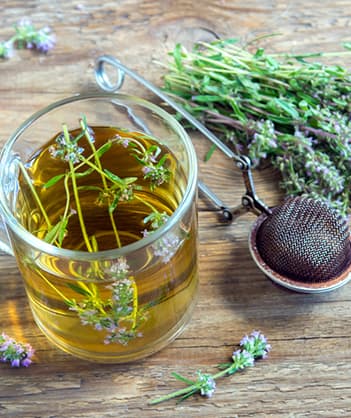 Blood pressure
Blood pressure
I wish we had the option to print without all the advertisement. Great information!
If you view the page from an iPhone and select reader view you can send the page without advertisements to your printer, or create a PDF.
Thank you!!!!
We do. Click on the Word icon and it will open in Word and you will not see any advertisements on there.
You can also right click your mouse and then choose the “Print Friendly” option at the bottom. Worked for me. I was able to print without ads & pics.
Why don’t you screen shot what you need and then paste it together in a document. Thats what I do to avoid the ads.
I installed an extension called Print Friendly in my Chrome Browser and it allows me to “edit” entire pages and photos in ads. Really cuts down on ink and paper use.
The article doesn’t mention freezing. I freeze mine in freezer bags and they work fine for months in cooking when I don’t want to run to the store.
Hi Patricia,
Thank you for your comment. Freezing is indeed one of the best ways to maintain the essential oils and flavors of delicate herbs such as dill, fennel, thyme, basil, and chives.
Do you have to dry it first before freezing?
Can you make a tonic or exliser using thyme? If so what’s the instructions
Hi Sarah,
Yes, you can 🙂 You can make an elixir, using alcohol and a sweetener (usually honey). Simply combine equal parts of herbal honey and herbal tincture. Fill a pint jar with thyme. Pour 1/3 pint of honey over the herbs, covering them all the way. Pour brandy or vodka over herbs and honey to fill the jar. Place a plastic lid on the jar and shake well. Store in a dark cupboard for about a month. Strain the herbs. Enjoy the elixir 2 ounces at a time. Keep refrigerated to preserve longevity.
Many blessings and good health!
Thyme is also one of the better herbs to create a flavored oil, in my opinion. I like mine strong so I add about 4-5 very well cleaned sprigs per cup of olive oil, or sometimes avocado oil. I like to have a good selection of flavored oils and vinegars in this fashion, as they are great for impromptu seasoning, both when cooking and on raw foods. There is no better “bread dip” to accompany a bread basket than a dab of thyme oil, a dab of garlic oil, and some fresh ground pepper. Unless you add a drizzle of good aged balsamic vinegar, of course! 🙂
Hi Hiai,
Thank you so much for sharing this recipe with us.
Sometimes good food is based on simple ingredients that succeed in creating a magical combination and flavored oils.
Many blessings and good health!